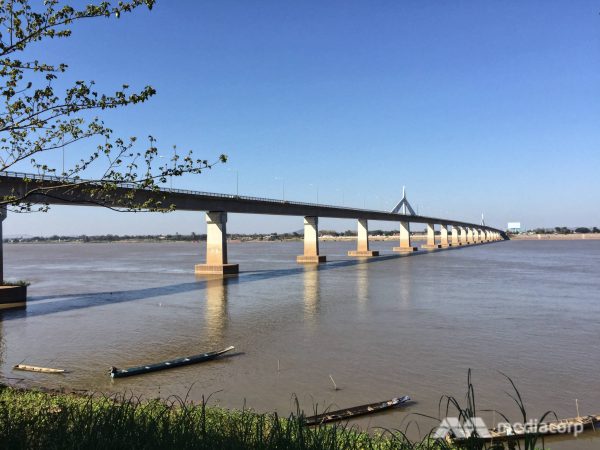SINGAPORE, 22 January 2020. Four ‘Friendship Bridges’ span the wide majestic Mekong River as it creates a meandering borderline between Thailand and Laos but just how friendly are these border bridges?
When the first bridge opened back in 1994, spanning the river between Nong Khai in Thailand and Vientiane province in Laos, it promised a bright new era of trade and tourism. Since then three more bridges connect the border towns of Mukdahan (no2), Nakhon Phanom (no3) and Chiang Kong (no4) with their counterpart riverside towns in Laos.
For the towns that face each other across the broad river, building friendship and expanding trade and tourism hasn’t been smooth sailing.

It is particularly rough for the growing breed of big bike tourists who dust off their superbikes and ride to the nearest Friendship bridge on tours that criss-cross Thailand and Laos. They are cashed up and known for splashing their dollars in remote villages where they enjoy a pit stop for snacks or an overnight stay for acholic celebrations dedicated to retelling the day’s adventures and near encounters with the grim reaper.
But they are not given a rousing welcome at border checkpoints even if they top up the low-season bookings in places like Luang Prabang long after the tour groups head home to avoid the rainy season.
Friendship bridges in name but the reality is that since the day they opened the countries that built them have trussed them up in red tape.
After a couple of bridges opened, regional tourism associations and agencies such as the Mekong Tourism Coordinating Office took note.
In the past, the annual Mekong Tourism Forum talked about one-stop-shop immigration processing at the bridges to streamline the process. But over the years smoothing the rough edges of overland travel became a bore and a waste of precious conference time. There were far more “cool subjects” deserving of a good natter.
Today, MTF prioritises to ensure everyone chats about social media campaigns, ‘Mekong Moments’ and video stories that are often just sad examples of advertising clips on the cheap. MTF no longer addresses the challenges of the region’s tourism and the obstinate border obstacles between Mekong Region countries.
One challenge focuses on the fact that crossing a Friendship Bridge is not as simple as opening the throttle on your BMW for a 60 seconds sprint across the bridge. You will have to load the bike on a pick-up truck and pay for the crossing.
That unceremonious entry depends on your paperwork being in order and your ability to suss out the obstacle course that funds and nurtures officials in bureaucratic bliss. Around four departments at each end of the bridge are involved in making the crossing for motorcycle tourists as difficult as humanly possible.
They include immigration, customs, tourist police, land transport and some instance governor’s offices to pre-approve motorcycle paperwork ahead of the crossings.
Whatever the process at one end of the bridge, the entire routine repeats itself at the opposite end. In Laos, the process is fine-tuned with additional rules and demands for overtime payments. Motorcyclists tell horror stories of passing one checkpoint only to fail at the other end of the bridge. It is possible to clear the obstacles on the outward leg and fail to pass them when you return to the same checkpoint to re-enter Thailand. Nothing is set in stone, and understandably Facebook group pages frequently allege that a chain of corruption hampers cross-border tourism.
One rule that upsets motorcycle tourists entering Laos is the requirement that for groups of four bikes or more they must hire an official guide (sometimes local police) to ride pillion or sit in a back-up vehicle for the duration of the Lao visit. In an episode reported at a border checkpoint earlier this month, Lao officials fined four travellers riding two motorbikes THB5,000 each despite the four-plus rule being based on bikes, not riders and pillions.
Friendship bridges between Thailand and Laos are essential to ease the transport of containers and heavy-duty transport on routes that link to China, but they also have a tourism role and the early promise of using them to encourage overland tourism, both by car and motorcycle has long been ditched or ignored.
This April, the Mekong Tourism Forum will meet in Bagan where the promotion of tourism will head the agenda once more. Based on the track record of recent forums, the glaring shortcomings at the region’s border checkpoints and the very future and health of the Mekong River will once more be shunted aside as not being politically correct.








So true, I was actually happy with the new rules limiting falangs to 2 land crossings a year because it meant I didn’t have to accompany my wife on her frequent visits.
The border guards and immigration are an obstacle course with ever changing rules and places to go/stand/wait while they fill out forms in quintuplicate using carbon paper. I think Canada gave up carbon paper in the 60’s.